Register with us

Research Associate
Anjali has completed her Master’s in Development Studies from Ambedkar University, Delhi. Her primary interest lies in studying informal and unpaid forms of labour through qualitative research and fieldwork, which inevitably intersect with gender and caste dimensions in India. Apart from creating hand-made illustrations for people’s movements and research work, she engages with stage and screen projects as a theatre artist.
As part of the ongoing Amrut Mahotsav to celebrate the 75th Anniversary of Indian Independence, Gender Samvaad was launched on April 16, 2021 with around 1400 participants including rural women, state representatives, CSOs and academia from across India. The event was attended by senior officials of the Ministry comprising Shri. Nagendra Nath Sinha, Secretary, Ministry of Rural Development; Smt. Alka Upadhyaya, Additional Secretary, Ministry of Rural Development; and Joint Secretary, DAY-NRLM, Smt. Nita Kejrewal. Community resource persons, who are women SHG members from various states, were also invited to share their experience of overcoming several barriers to improve their lives and livelihoods. The theme for the inaugural session was “Gender Transformative Rural Livelihoods”.
During the launch event, a compendium of case studies “Stories of Resilience and Hope” documenting good practices and stories of resilience and transformative changes among SHG women shared by various State Rural Livelihoods Missions, was launched at the event by the Secretary, Rural Development. The stories narrate systemic processes adopted to strengthen women’s groups in developing strong collectives as well as individual identities. A short film was launched by the Joint Secretary, DAY-NRLM, Smt. Nita Kejrewal, showcasing IWWAGE’s support for operationalising DAY-NRLM’s gender strategy and the various pilot interventions underway to set up institutional platforms for rural women to access justice, information, rights and entitlements. Three States- Andhra pradesh, Jharkhand and Kerala presented during the inaugural session which narrated collective struggles of women’s access to livelihoods opportunities by challenging the social norms and emerge as chamipons levraging the SHG platform. This was followed by a panel discussion that included leading gender and livelihoods experts to emphasise the importance of improving women’s livelihoods, their agency, and their understanding of their rights and entitlements. The panel comprised Dr. Lakshmi Lingam, Dean, School of Media and Cultural Studies, TISS; Ms. Sejal Dand, Director and Founder Member, ANANDI; and Dr. Renu Golwalkar, Global Director, Gender, Youth and Social Inclusion, Engender Health. The session was moderated by Soumya Kapoor Mehta, Head IWWAGE. Click here for the recording.
The second Gender Samvaad was held on July 2, 2021 on the topic :Ensuring an inclusive response and recovery from COVID:Best practices from SRLMs. The event focused on the challenges posed by the second wave of the pandemic and the extent to which States have been able to respond to these by leveraging the collective potential and solidarity of women’s groups. The dialogue showcased best practices from the states in responding to the emerging needs ranging from access to health and other services, information related to COVID-19, access to food, and opportunities for work. The online event brought together the voices of state rural livelihood mission officials together with those of women affected by the pandemic. The focus states in the second dialogue were Bihar, Kerala and Meghalaya, talking about how they have been ensuring food security for communities and access to health information across all age groups. The second dialogue was attended by more than 2400 participants form across the states.
Smt. Aparajita Sarangi, Member of Parliament; Shri. Nagendra Nath Sinha, Secretary MoRD; Smt. Alka Upadhyaya, Additional Secretary; Smt. Nita Kejrewal, Joint Secretary from MoRD were present in the second edition of the Gender Samvaad. Senior officials from the States inlcuded Shri. Balamurugan D, CEO cum State Mission Director, Jeevika, Secretary RD, Govt. of Bihar; Shri. S. Harikishore, Executive Director, Kudumbashree, Govt. of Kerala; and Shri. P. Sampath Kumar, Principal Secretary, Govt. of Meghalaya, C&RD Dept. Health and Social Welfare Dept. Senior officers from the three States shared their insights and experiences on the response and recovery mechansim establihed by the States using the DAY-NRLM social capital. The event also brought voices from the field, and experience sharing from women Community Resource Persons who spoke about the problems faced by their families, coping mechanisms adapted, the role their groups have played during the pandemic, the duties performed at the village level and preparedness for future challenges. View the recoding here.
Background: Gender Samvaad is a national virtual platform of DAY-NRLM used to generate greater awareness on DAY-NRLM’s interventions across the country. It is also an opportunity to share and learn best practices amongst the States Rural Livelihoods Missions and hear voices from SRLM cadres and SHG women. Two such events have been held earlier on 16 April 2021 and 2nd July 2021. The third Gender Samvaad event was organized to highlight issues around food & nutrition security and initiatives undertaken by the State Rural Livelihoods Missions and SHG members for the same. The United Nations standing committee on nutrition defines food and nutrition security as:
“Food and nutrition security exists when all people at all times have physical, social and economic access to food, which is consumed in sufficient quantity and quality to meet their dietary needs and food preferences, and is supported by an environment of adequate sanitation, health services and care, allowing for a healthy and active life.” Food Security has 4 dimensions: Availability, Access, Utilization and Stability of food while Nutrition Security includes the additional dimensions of Care and feeding practices and Health and Sanitation.
Integrating FNHW within DAY-NRLM: In 2019, the DAY-NRLM adopted a ‘Dashasutra’ strategy for SRLMs, under which Food Security, Nutrition, Health and WASH (FNHW) and Gender are included as essential components needed to bring about social development. This inclusion of FNHW demonstrates the commitment of DAY-NRLM to contribute to overall improvement in health and nutrition of the community. Provision of food and nutrition security is an essential part of the FNHW strategy. To ensure the four dimensions of food security, i.e. Availability, Access, Utilization and Stability of food, DAY-NRLM envisages the following approaches, (1) establishment of nutrition garden and home consumption of produce of nutrition gardens by SHG families (2) increase in access of SHG households to Take Home Rations (THR) under ICDS (3) Promotion of nutrition-sensitive agriculture, (4) Improved coverage of SHG households under Public Distribution System (PDS) and (5) Addressing gender issues related to consumption of food. The effective operationalization of these approaches can be achieved through inter-departmental convergence between DAY-NRLM and M/oWCD, Ministry of Agriculture and Food and Public Distribution and intra-departmental convergence between FNHW and Farm Livelihoods verticals.
FNHW through a gender lens: In India, an effort for health and nutrition cannot reach fruition if certain critical issues are not addressed. Evidence demonstrates that, equitable distribution of food within the family is not achieved without addressing the GENDER NORMS. The common practice of women eating last, least and leftovers inhibits women from reaching their optimum nutritional potential, even if there is availability of adequate food in the home. Decisions on procurement of food products and their distribution within the family are also often taken by the head of the household who are mostly men, keeping members like women, young children and elderly at the fringes within the home. With this in mind, DAY-NRLM incorporates a gender lens while designing interventions around all aspects of social development. This gender intentional approach is being used in efforts for food and nutrition security as well.
Institutional partnerships to strengthen FNHW interventions for better gender outcomes
i) Promoting convergence between Farm Livelihood and FNHW of DAY-NRLM, MoRD for establishment and utilization of nutrition gardens by SHG families: The Ministry of Rural Development has been undertaking several steps to enhance promotion of nutrition gardens at household, community, Anganwadi and panchayat land across the country through DAY-NRLM and MGNREGA. A detailed Advisory was shared with SRLMs by the Farm Livelihoods (FL) vertical of DAY-NRLM to establish nutrition gardens, in May 2019. This was further supplemented by including work done for developing nutrition garden under the ambit of MGNREGA through a DO letter in August 2020. Additional thrust was given to this effort during the Poshan Maah, 2020, when the MoPR, MoRD and MoWCD issued a Joint Directive to all State Chief Secretaries to conduct a month-long drive to plant nutrition garden to enhance Food Security. As a result of these concerted efforts, 77.89 lakh Agri-Nutrition Gardens have been promoted across the SRLMs till December, 2021.
Evidence suggests that the mere presence of a nutrition garden at home does not translate into equitable gender norms for improved dietary diversity. There is a gap between having access to food and actually consuming it. Hence, along-side growing food, families also need to be counseled to include the produce of nutrition garden in their daily diet. Under FNHW component of DAY-NRLM, awareness sessions on diet diversity have been initiated through monthly discussion in SHG meetings and counseling the families through community-based events, home visits, village events etc. Some SRLMs have progressed in this regard, and Gender Samvaad could be an appropriate forum to share their experience with other SRLMs. Also the message of combining nutrition garden establishment with Social Behaviour Change Communication (SBCC) to emphasize the importance of planting nutrition gardens and supplementing it with counseling for behavior change so that each family consumes the produce of the garden, thereby improving diversity in their diet and moving a step further towards reaching a state of Nutritional security can be reiterated. Such dialogue will also enhance the opportunity of convergence within DAY-NRLM verticals and concerned departments.
ii) Promoting convergence between MoRD and MoWCD to improve access of SHG women to Take Home Rations (THR) and other services: The Ministry of Women and Child Development (MoWCD) launched the ICDS program on 2nd Oct 1975 and it remains one of the critical pillars for provision of food in the form of Take Home Rations (THR) and fresh cooked meals for pregnant and lactating women, children below 6 years of age and adolescent girls (under the SAG scheme). Under DAY-NRLM, SHG family with pregnant and lactating women, children below 6 years and adolescent girls are encouraged to avail the THR services from the local Anganwadi Center. A few SRLMs have collaborated with DoWCD for engaging SHGs producing and providing THR to Anganwadi Center.
iii) Promoting convergence between M/oRD and Ministry of Agriculture: Agricultural practices/cropping patterns also play a significant role in the access to foods for a community, which impacts their dietary pattern. Despite producing large quantities of nutrient-rich crops such as Rice, Pulses, Millets etc, India harbours one-third of the world’s stunted children. Evidence suggests that a move towards cultivation of nutrient-rich indigenous food crops such as Jowar, Bajra and other millets and diversification of crops can benefit the nutrition status of the local community. Women empowerment through Agricultural initiatives also has an important role to play in improving overall nutritional status.
iv) Convergence between MoRD and Department of Food and Civil Supplies for improved coverage of SHG households under Public Distribution System (PDS): Similarly, the Public Distribution System (PDS) plays a crucial role in reducing food insecurity by acting as a safety net by distributing essentials at a subsidized rate. With a network of more than 400,000 Fair Price Shops (FPS), the Public Distribution System (PDS) in India is perhaps the largest distribution machinery of its type in the world reaching 80 crore persons in the FY 2020-21. Under DAY-NRLM, linking of SHG members with entitlements and services are encouraged including access to subsidized food and other household materials under the PDS.
Objectives of 3rd Gender Samvaad:
AGENDA
| Time | Session | Speaker |
| 3:30 – 3:40 pm | Welcome and Opening Remarks | Smt. Nita Kejrewal
Joint Secretary, MoRD |
| 3:40 – 3:45 pm | Video on role of SHG members in addressing malnutrition | Smt. Nita Kejrewal
Joint Secretary, MoRD |
| 3:45 – 4:00 pm | Initiatives under DAY-NRLM and need for convergence by MoRD | Sh. Nagendra Nath Sinha
Secretary, MoRD |
| 4:00 – 4:05 pm | Video on POSHAN Maah-2021 activities under DAY-NRLM | Smt. Nita Kejrewal
Joint Secretary, MoRD |
| 4:05 – 4:25 pm | Keynote Address | Dr. Vinod Kumar Paul
Member, NITI Aayog |
| 4:25 – 4:40 pm | Addressing nutritional requirements of Women & Children through ICDS/POSHAN Abhiyaan & role of Self-Help Groups
by MoWCD |
Shri Dhrijesh Tiwari
Statistical Adviser, MoWCD |
| 4:40 – 4:55 pm | Women’s rights & entitlements for food & nutrition security & role of government institutions by National Commission for Women | Ms. Meeta Rajivlochan Member Secretary, NCW |
| 4:55 – 5:10 pm | Presentation on behavioural change communication around FNHW activities and nutrition-sensitive agricultural practices undertaken in the State by SRLM, Bihar | Shri Balamurugan D, Secretary, Rural Development Deptt., Government of Bihar cum CEO, BRLPS, SRLM
CRP – 5 mins CEO – 10 mins |
| 5:10 – 5.25 pm | Presentation on Nutrition Enterprises and other aspects of Nutritional Security by SRLM, Maharashtra | Dr. Hemant Wasekar, CEO, SRLM, Maharashtra
CRP – 5 mins CEO – 10 mins |
| 5:25 – 5:40 pm | Evidence for role of Women’s Collectives in facilitating Household Food Security by IFPRI | Ms. Kalyani Raghunathan, IFPRI |
| 5:40 – 5:55 pm | Presentation on successes, challenges and way forward for Maitri Baithak and Pariwar Chawpal by SRLM, Chhattisgarh | Smt. Effat Ara, Incharge-Mission Director, SRLM
Chhattisgarh CRP – 5 mins CEO – 10 mins |
| 5:55 – 6:10 pm | Question & Answer | Moderator |
| 6:10 – 6:15 pm | Closing remarks and vote of thanks by MoRD | Sh. H.R Meena
Deputy Secretary, M/oRD |
The fourth Gender Samvaad was co-organized by Deendayal Antyodaya Yojana-National Rural Livelihoods Mission (DAY-NRLM), Ministry of Rural Developmen and Institute for What Works to Advance Gender Equality (IWWAGE) on September 22nd 2023. The virtual event brought together over 8000 participants, including senior officials MoRD, Ministry of Women and Child Development, Government of Bihar and state government officials, practitioners, gender experts, academia, civil society actors, and members of self-help groups.
Gender Samvaad, is a unique, joint attempt between DAY-NRLM and IWWAGE to establish a shared platform to generate awareness on DAY-NRLM’s gender interventions across the country, with a focus on hearing voices from the states and of SHG members.
In his keynote address, Additional Secretary, Ministry of Rural Development, Shri Charanjit Singh expressed concerns over the statistics on gender based violence and emphasised on the role that community based institutions can play in addressing this issue. He also stressed on inter-ministerial convergence to address Gender Based Violence, especially with Ministry of Information and Broadcasting and Ministry of Education for awareness generation and sensitisation.
Joint Secretary, DAY-NRLM, Smt. Smriti Sharan highlighted the extensive efforts undertaken by DAY-NRLM in empowering women and creating model institutions to address women’s issues in rural areas particularly through the platform of Gender Resource Centre.
Community resource persons (CRP) from various states including Jharkhand, Kerala and Odisha were invited to share their experience of institutional strategies adopted to address gender based violence. Smt Rajani Dandasena from Odisha shared the experience of the functioning of the Prerna Kendra (Gender Resource centres) at Gram Panchayat level. The Prerna Kendras have established strong linkages with other departments through Gender Forum and have been able to address cases of Violence. The Gender Campaign launched in November 2022 has also led to widespread awareness on GBV and demanding public action through the institutions of the women. Women shared experiences of addressing issues like witch hunting, drug abuse, sexual violence, etc.
Smt. Mahua Roy Chaudhary from Jeevika, Government of Bihar highlighted the importance of gender training, learning pedagogies and use of IEC materials leading to creation of gender responsive institutions particularly Didi Adhikar kendras for addressing violence that is deep rooted in patriarchy and social norms. She also emphasized the political empowerment of women as ward members and mukhiyas in the state. She emphasized the importance of sustainability of these institutions in continuing delivering women’ s empowerment.
A panel discussion followed which included Joint Secretary from Ministry of Women and Child Development, Gender Expert and Women’s rights lawyer to emphasise the importance of SRLM and system related opportunities like legal remedies including fast track courts, horizontal and vertical gender training across different stakeholders and inter-ministerial convergence adopting multi-pronged strategies to address GBV. The panel discussed innovative financing for sustainability, safe spaces for women like Shakti Sadan and short stay homes, strengthening data driven governance and economic agency of women. The conversation laid out the scope of convergence between Naari Adalats under Mission Shakti with Gender Resource Centres under DAY-NRLM. The Samvaad 2023 ended with the need to come together to address the core issues of women through focus on preventive measures, convergence and innovative and local approaches of problem solving.
Gender-Based Violence (GBV) against women, girls, and gender-diverse individuals represents a fundamental violation of human rights, severely impacting their well-being and capabilities. It also imposes significant social and economic costs, both in terms of direct financial implications and the indirect losses resulting from reduced productivity. Ending GBV is essential for sustainable human development, and it remains a critical priority for Deendayal Antyodaya Yojana-National Rural Livelihoods Mission (DAY-NRLM). GBV arises from unequal power relations between men and women, manifesting in disparities in productive and reproductive labour, paid and unpaid work, resources, social recognition, and decision-making power.
Over the past two years, DAY-NRLM has spearheaded a nationwide Gender Campaign (Nayi Chetna) in 2022 and 2023, aimed at raising public awareness about GBV and encouraging recognition, acknowledgment, and reporting of violence for public action. GBV not only devastates survivors and their families but also imposes significant social and economic costs on communities. Given the scale of the issue, DAY-NRLM has focused on strengthening the functioning of key rural institutions such as self-help groups (SHGs), village organizations (VOs), cluster-level federations (CLFs), social action committees, and Gender Resource Centres (GRCs). These structures serve as the closest points of contact for rural women seeking support on issues such as rights, entitlements, and GBV.
Addressing the complex challenge of GBV requires ongoing dialogue, partnerships, and a long-term vision. DAY-NRLM is committed to working with development partners and counterpart ministries to prevent and address GBV. Assessments from the 2022 and 2023 campaigns highlighted the need for greater convergence between schemes from various ministries, including Rural Development, Women and Child Development, Panchayati Raj Institutions, Legal Services, and Home Affairs.
The recently concluded fifth edition of Gender Samvaad built on the ongoing efforts of the Government and emphasized the importance of establishing a shared mandate to address GBV across all levels of administration. A key focus was on disseminating the findings from two years of the Nayi Chetna campaign. IWWAGE and PRADAN presented the Nayi Chetna Assessment Report and Process Document, offering insights and recommendations to strengthen future strategies for addressing GBV. The session drew on expert opinions and practical experiences to explore pathways for mitigating the challenges of responding to GBV, addressing redressal mechanisms for survivors, the challenges faced by cadres, and lessons learned from the field.
The discussions at Gender Samvaad 5 underscored the need for continuous engagement with experts, government colleagues, and field practitioners to address implementation barriers and improve local-level GBV response mechanisms. This post-event reflection reaffirms the Government’s commitment to advocating for stronger gender-responsive policies within State Rural Livelihoods Missions (SRLMs) and the broader NRLM framework. Gender Samvaad will continue to serve as a vital platform for amplifying best practices, sharing field experiences, and advocating for collaborative measures to combat GBV.

Head – Communications and External Engagement
Rachita Malik is a development professional with over 12 years’ experience leading communication portfolios for national and international organisations. She specialises in Communication for Development, Health Systems Strengthening, Public Health, and Nutrition, and has worked with Piramal Foundation, UNICEF (consultant), Save the Children, and Navjyoti India Foundation.
A passionate traveller, she finds the greatest joy in working with children and aspires to contribute towards a world where every child realises their right to survival, protection, development, and participation. Rachita holds a Master’s degree in Development Communication and Extension from Lady Irwin College, University of Delhi.

Research Associate
Sharati holds a Master’s in Political Science from the University of Delhi and a Bachelor’s from Lady Shri Ram College for Women. Her research interests include human development and international politics, with a focus on gender.
She has experience working with central and state government bodies. In her free time, Sharati enjoys reading and exploring films and theatre in the city.

Associate Director – Research & Policy
Aditi brings over 14 years of expertise in gender, youth development, education, and economic empowerment. She excels in designing impactful programmes, conducting qualitative research, and advancing evidence-based policy initiatives for gender equity.
Before joining IWWAGE, Aditi worked with ICRW on developing assessment tools for teachers and systems under the Life Skills Collaborative and evaluating the impact of COVID-19 policies on informal women workers in Delhi NCR through the REBUILD project. She has also developed a gender-integrated life skills curriculum for adolescent girls, licensed by Gap Inc., and led curriculum development and trainer sessions for programmes funded by the Bill & Melinda Gates Foundation and the MacArthur Foundation.
Aditi holds a bachelor’s degree in History from Delhi University, a master’s in Modern Indian History from Jawaharlal Nehru University, Delhi, and a master’s in the History of Science, Medicine, and Technology from the University of Oxford.

Communication Manager
Communication Manager at IWWAGE. Previously, he worked with organisations including ACCESS Development Services, AIACA and Oxfam India.
Karunakar holds a Master’s and Bachelor’s Degree in Journalism and Mass Communication from Guru Gobind Singh Indraprastha University, Delhi.
His core experience lies in brand communications. Karunakar is passionate about strategic planning, design, content development and dabbles in photography and videography. In his free time, he likes to pamper dogs, travel, binge-watch on OTT platforms and party.

Research Associate
Vidhi holds a Master’s degree in Public Policy and Governance from Azim Premji University, Bengaluru. She has previously interned with SEWA Bharat and PRS Legislative Research. Before joining IWWAGE as a Research Associate, she was working in the capacity of a Research Analyst in a private consulting firm based out of Lucknow. In this role, she was involved in monitoring and evaluation research studies at the intersection of gender and health. From her schooling years, she has been active in advocating for gender rights and wants to continue working in the domain. Her areas of interest primarily include intersections of gender and data. Additionally, she describes herself as an avid consumer of Hindi cinema and is very highly influenced by the actor Shah Rukh Khan.

Executive Director, IWWAGE
Radha is a qualified senior level professional having more than three decades of expertise in the development and humanitarian sector—in operations, management and programmes. She has worked in South Asia, particularly in India and Nepal, with multiple stakeholders including governments, UN agencies, INGOs and civil society organizations. Prior to joining IWWAGE, she has held diverse senior level positions including representative positions in the United Nations.
Her thematic excellence lies on gender equality and inclusion, women empowerment, gender based violence, emergencies, social protection, livelihood and skill building, environment and climate, and migration.
testpopuptestpopuptestpopup

Research Manager
Surabhi Awasthi is a Research Manager at IWWAGE, and is currently working with the Strengthening Women’s Institutions for Agency and Empowerment (SWAYAM) for the National Rural Livelihood Mission. She has previously worked with the National Human Rights Commission as a consultant providing research support in the policy and research division on the issues related to women and children. Before joining IWWAGE, she led the research team for the Geography of Philosophy Project based at IIT, Delhi, and headquartered at the University of Pittsburgh (USA). She is a trained qualitative researcher with experience in narrative inquiry and ethnography; her research interests include gender, labor, and changing family institutions. Surabhi holds an M.Phil. in Social Work from the University of Delhi, where she was awarded a Junior Research Fellowship from the University Grants Commission, India. Through her work, she aims to bridge the gap between academia and practical policy goals, particularly related to furthering women’s equality in India through education and welfare policy. In her free time Surabhi enjoys cooking and researching about food history and food science, and spend time with her cats.

Project Manager
I am a social sector professional with 10 years of experience in various facets of social development. My expertise encompasses livelihoods promotion, project management, grant & donor management, project monitoring, and the design & delivery of gender training curriculums. I have managed and implemented projects at both national and grassroots levels. Besides this, I facilitated gender integration initiatives by facilitating ToT, implementing training programs, and awareness campaigns among the mission staff, students, and NHG (Neighbourhood Groups) members, I also worked to implement an Anti-Human Trafficking project of Kudumbashree.
I hold a Master’s degree in Sociology and have recently completed Masters in Women and Gender Studies. Prior to my current role at IWWAGE, I worked with esteemed organizations, including Kudumbashree – Kerala State Poverty Eradication Mission, Snehitha Gender Help Desk at the Kudumbashree District Mission, Industree Craft Foundation, and educational institution. I have managed projects funded by USAID (POWER project -Producers Owned Women Enterprises), and led other FCRA, CSR, and Philanthropic Foundations funded projects. My work has involved managing projects funded by organizations like Bank of America, Cartier Philanthropy, Wells Fargo, BNP Paribas, HDFC, Empowerment Foundation etc.
During the launch event, a compendium of case studies “Stories of Resilience and Hope” documenting good practices and stories of resilience and transformative changes among SHG women shared by various State Rural Livelihoods Missions, was launched at the event by the Secretary, Rural Development. The stories narrate systemic processes adopted to strengthen women’s groups in developing strong collectives as well as individual identities. A short film was launched by the Joint Secretary, NRLM, Smt. Nita Kejrewal, showcasing IWWAGE’s support for operationalising NRLM’s gender strategy and the various pilot interventions underway to set up institutional platforms for rural women to access justice, information, rights and entitlements. Three States- Andhra pradesh, Jharkhand and Kerala presented during the inaugural session which narrated collective struggles of women’s access to livelihoods opportunities by challenging the social norms and emerge as chamipons levraging the SHG platform. This was followed by a panel discussion that included leading gender and livelihoods experts to emphasise the importance of improving women’s livelihoods, their agency, and their understanding of their rights and entitlements. The panel comprised Dr. Lakshmi Lingam, Dean, School of Media and Cultural Studies, TISS; Ms. Sejal Dand, Director and Founder Member, ANANDI; and Dr. Renu Golwalkar, Global Director, Gender, Youth and Social Inclusion, Engender Health. The session was moderated by Soumya Kapoor Mehta, Head IWWAGE. Click here for the recording.
Gender Samvaad is a joint initiative between DAY-NRLM and IWWAGE to create a common platform for raising awareness of NRLM’s interventions across the country, focusing on best practices and amplifying voices from the states and the field.
Gender Samvaad provides states with the opportunity to:

Research Fellow
Arpita Paul is a statistician cum demographer with over 10 years of quantitative research experience in public health, market research, survey implementation around RMNCH issues in different contextual settings. Her research activities mainly focused on social determinants of health and wellbeing, understanding various aspects of maternal & child health, factors determining the health, wellbeing and living arrangement of the elderly.
Before joining IWWAGE, she was working with Public Health Foundation of India, Gurugram where she was the lead analyst. She has substantial experiences in survey design, large scale data handling, and advanced statistical analysis along with expertise in various statistical software. She has a PhD in Demography from International Institute for Population Sciences, Mumbai and a post graduate degree in Statistics from Banaras Hindu University, Varanasi.
In her spare time, she enjoys reading and dancing.

Communication Manager
Pallavi works as Manager- Communications & Learning at IWWAGE. She was last working as Communication and Advocacy Manager for Reckitt’s CSR programmes, Dettol’s Banega Swasth India (DBSI) initiative.
As far as her education goes, she has a master’s degree in Sociology from Jawaharlal Nehru University. She also comes with experience in policy with a demonstrated history of working in the non-profit organization management industry. To name a few, she has worked with International Initiative for Impact Evaluation (3ie), Aga Khan Foundation, Teach for India, FXB India. She is skilled in strategic communications, advocacy, project management, research, Sociology, data analysis (qualitative) and gender studies. She likes to spend time with her dog, bake cakes and try various cuisines in her free time.

Research Associate
Trisha is a Research Associate at IWWAGE. She has a Bachelors in Economics from St. Xavier’s College, Kolkata and a Masters and MPhil in Economics from Jawaharlal Nehru University, New Delhi. Her MPhil thesis is titled Changing Contours of Regional Value Chains in East Asia. Her research interests include labour, gender, trade, value chains, migration, care economy and fragile and conflict affected areas. She has also worked on Indian agriculture, currency flows and gender budgeting for different projects.

Associate Director, LEAD at Krea University
Preethi Rao oversees the leveraging evidence function (collaborations, training, learning and communications, and innovations) and contributes to strategic decision-making at LEAD. Preethi has served the organization in various capacities such as Head – Innovation, Senior Operations Manager and Researcher (MSME).
As an Innovation Champion, she drives new initiatives and is responsible for conceptualizing new areas of interest for the organization. Prior to heading the Innovation vertical, Preethi has overseen the entire field data collection and digitization operations (spanning more than 10 states) of LEAD in her capacity as Senior Manager (Operations & Development). Preethi was the Director of the Jaipur Digital Payments Lab at Catalyst, where she oversaw the entire on-ground execution, managed partner/stakeholder relations, managed donor liaison and expectations, anchored M&E and was involved in the production of programmatic learning outputs. For IWWAGE, an initiative of LEAD conducting research on women’s economic empowerment, she serves as the Innovation Lead, assisting in setting up the hub, providing particular assistance in terms of confirming policies and procedures, and setting up outreach protocols in coordination with the team.
Apart from donning multiple hats at LEAD, over the years Preethi has undertaken interdisciplinary studies on access to finance for small and medium scale enterprises and the influence of macroeconomic policies on the low-income populations. She has also been involved in developing, designing and leading research studies and short term projects in open data, financial inclusion and MSMEs.
Preethi holds a Master’s Degree in Management from IFMR Graduate School of Business where her focus areas were Finance and Marketing.
In her free time, Preethi likes to write poetry, read fiction and watch documentaries on Psychology or experimentation on human behavior.

Executive Director, LEAD at Krea University
Sharon Buteau combines expansive experience of over 18 years in research and international development, with over 7 years in the field of digital financial services and financial inclusion. Sharon is deeply passionate about finding effective solutions to promote enterprise growth and development, and realising the untapped potential of micro and small businesses.
At LEAD, Sharon focuses on bringing the right combination of talent, expertise and stakeholders together to ensure that investments and efforts are perfectly aligned with the desired goals. Sharon holds significant expertise on how to leverage co-creation, collaborative processes, as well using the power of data from the ground up can improve socio-economic outcomes for individuals, households and enterprises. She has in-depth knowledge in “right-fit research methods” and significant experience in the domain of financial capabilities and well-being, and small business and entrepreneurship development.
Sharon started her journey at LEAD in 2008, when she arrived in India with a strong desire to improve society by producing impactful knowledge that can bring positive change. Prior to joining LEAD, Sharon was an economist with Analysis Group in Montreal Canada.
Sharon holds an MSc in Economics from the Universite du Quebec a Montreal, as well as an MA in Social Research Methods from the London School of Economics.

Senior Policy Manager
Sruthi is a Senior Policy Manager at IWWAGE. In the past, she has donned various roles in the policy and government consulting realms working on a range of developmental issues with think tanks, government agencies, civil society organizations and citizens’ groups. Before joining IWWAGE, she worked with UN Women as the Coordinator of the Feminist Policy Collective.
Sruthi’s experience comprises of diverse engagements around feminist economics, women’s entrepreneurship, gender-sensitive urban planning as well as documenting the gendered impact of development projects. She holds a Bachelors degree in Engineering from Mumbai University, a Masters degree in Public Policy & Governance from Azim Premji University, Bangalore and a PG Diploma in Communications from Xavier Institute of Communications, Mumbai. She is generally always on a quest to find feminist perspectives in everyday life.

Research Associate
Tanay has completed his MSc in Development Economics from University of Sussex and MA in Economics from North Bengal University. Before joining IWWAGE, he was working at SUVITA, a non-profit start-up working on Child Immunization, and helped to scale up the SMS Reminder and Immunization Ambassador programmes. He also worked with DevInsights Pvt. Ltd. as a research executive and coordinated different projects. Tanay is interested in impact evaluation methodologies and cutting edge quantitative and qualitative research. His postgraduate dissertation focused on the economic impact of Self Help Groups. His areas of interest include financial inclusion, women economic empowerment, econometrics and impact evaluation.

Documentation Specialist
Aikantika is a Documentation Specialist at IWWAGE. She has an undergraduate degree in Sociology from Miranda House, Delhi University and a postgraduate degree in Rural Development and Governance from TISS, Hyderabad.
Aikantika has a work experience of over 6 years, mostly with women’s groups. She started her career with SERP, Andhra Pradesh in the MLE team on a World Bank project where she worked very closely with SHGs. She has also worked with CDFI at IFMR on conceptualising and implementing technology innovations for social benefit delivery with SHGs and Anganwadis as well as on the software development, testing and maintenance for the Pradhan Mantri Matru Vandana Yojana. Before moving to IWWAGE, she was working with the Population Council as a public health researcher where she was a part of a systematic review on women’s groups and health. She also co-led an implementation research study with NIRD&PR, Hyderabad to understand NRLM’s health and nutrition intervention with SHGs.

Research Manager
Parushya is a Research Manager at IWWAGE. He supports research design and handles quantitative data and analytics on multiple projects focused on studying the informal economy, urban poverty, and social protection schemes. Before joining IWWAGE he was part of research projects assessing the role of property rights and public services on the economic and social mobility of urban poor populations.
A civil engineering graduate from the National Institute of Technology Karnataka and Young India Fellowship, Ashoka University, he has more than 5 years of experience in the development sector. He has worked as an International Innovation Corps Fellow with the University of Chicago followed by multiple research and consultancy roles with various international development organizations and government departments in India.

Project Manager
Neelanjana is a researcher with an academic background in Economics and quantitative analysis. She has over five years of experience in conducting evidence-based research to inform challenging questions of public policy. Her areas of interest are education and financial inclusion with the cross-cutting theme of gender. She hopes to use her experience and knowledge to empower those who wish to create better lives for themselves, and thus, work towards inclusive and sustainable development. Previously, she has served at NITI Aayog’s Development Monitoring and Evaluation Office, and has published works on topics of human development while at Brookings Institution India Center. She is currently a Senior Research Associate at IWWAGE, a LEAD at Krea University initiative.
Neelanjana is a graduate of Columbia University’s School of International and Public Affairs where she obtained a Master of International Affairs and holds an undergraduate degree in Economics with Honors and International & Global Studies from Brandeis University.
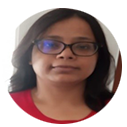
Co-Lead (SWAYAM)
Ms.Sarkar has an undergraduate degree in Chemistry (H) from University of Calcutta followed by a Post Graduation degree in Rural Development and Management from University of Kalyani, West Bengal. She has also won the Mathematics Olympiad.
She has an experience of twelve years in programme management, research, training and advocacy with national and international organizations like Ministry of Rural Development (Govt.of India), UN Women, UNDP, J-PAL and CInI (TATA Trust). Her core areas include Livelihoods and Gender.
In the recent past, she has been instrumental in drafting policy documents under the guidance of the Additional Secretary and Joint Secretary of MoRD, commissioned MGNREGS action research studies to provide gender responsive recommendations based on field findings and actively engaged with the Deendayal Antyodaya Yojna-National Rural Livelihoods Mission (DAY-NRLM) team to draft the gender protocol at NIRD&PR. AS UN Volunteer she has taken the lead in preparing teaching material for three months certificate course on Livelihood Planning and Supply Chain Management in Chhattisgarh SIRD adopting a case based training model. She also undertook qualitative research studies to review the Read India programme outcomes in Bihar.
She has been invited by various institutions like IIPA, VVGNLI, NIRD&PR, Bhartiya Vidyapeeth College of Nursing (Pune), Bengal National Chamber of Commerce & Industry to deliver session on Gender.
She will be based at IWWAGE, Delhi office.

Senior Research Associate
Rhitabrita is a Senior Research Associate at IWWAGE. She is a development economist and has worked extensively in the areas of social infrastructure, gendered economics, food security and ecological economics. Her areas of interest lie in creating sustainable solutions to socio-economic issues plaguing developing nations and LDCs.
She has a bachelor’s degree in Economics from Presidency University, Kolkata. Her graduation dissertation looked into the post-globalisation labour market and quality of labour in India. She has a master’s degree in Applied Economics from Jadavpur University, Kolkata with specialisations in Development Economics, Econometrics and Environmental Economics.
She has had more than 3 years of experience working as a full time researcher. Prior to joining IWWAGE she has worked as a Research Associate at the Center for research on the Economics of Climate, Food, Energy and Environment (CECFEE) at the Indian Statistical Institute (ISI), Delhi. She also worked in areas of child labour, women’s education and sanitation amongst migrant labour, food security, nurturing entrepreneurial abilities in both impoverished agricultural communities and urban labour, river plastic pollution and the economics of the Sundarbans ecology as a researcher and M&E specialist with SOCEO gGmbH. She is a regular writer for the Public Economist- Policy Monitor.
This factsheet is drawn from an ongoing IWWAGE-ISI study that seeks to examine the profile and background of women workers in contemporary industrial and urban landscapes – the kinds of opportunities available, barriers to participation, and aspirations and expectations from industrial employment. The study uses data collected from a survey of garment factory workers in Delhi NCR.The data is supplemented with more detailed information on current or aspiring women workers obtained through focus group discussions and interviews with women workers, and interviews with factory owners/managers, labour contractors, and so on.
This section draws from an ongoing Institute for What Works to Advance Gender Equality (IWWAGE) and Indian Statistical Institute (ISI) study that aims to understand the impact of structural transformation in agriculture on female employment over time, by assessing the role of women farm managers. This study uses data from the India Human Development Survey (2004-05, 2011-12) to understand the rise in female farm management, its variation along demographic dimensions, and the differences between cultivator households managed by men and those managed by women.
The methodology involves assessing the causal effect of switching to LPG on women’s outcomes by construction of a comparison group of households that are not eligible for or did not participate in PMUY. The study uses self-reported health status, and a time-use survey of women to measure the effect of LPG usage on time released for other activities. The results from this exercise would be used to design an experiment wherein information on long-term health benefits of LPG usage and the financial incentive under PMUY would be disseminated in randomly selected villages. This would be conducted by Accredited Social Health Activist (ASHA) workers by visiting randomly sampled households in ‘treatment’ villages on a monthly basis, and responses of women in targeted villages would be compared with those of other women at the end of a year. The study is being conducted in Indore region of Madhya Pradesh.
This study builds and tests a structural model that explains observed changes in FLFP using data on urban, married women from the Time Use Survey (1998) and various rounds of the National Sample Survey (NSS). The model focuses on women’s work participation, educational attainment, other characteristics, and time spent in the labour market, home production, and leisure.
Madhya Pradesh (MP) is the only state in India to have witnessed a rise in workforce participation rates (WPRs) of women in both rural and urban areas between 2011-12 and 2017-18. The increase in women’s WPR in MP was driven largely by increase in self-employment in the rural areas and regular employment in the urban areas. According to the Periodic Labourforce Survey in 2017-18, more than half of the female workforce in the state is self-employed, with a higher incidence of self-employment in rural areas. While approximately 88 percent of the rural self-employed women in MP are engaged in unpaid work, the share of women in own account enterprises is substantially high in urban MP. The distribution of casual women workers suggests very few women engaged under MGNREGA and other public works as 96 percent women in casual employment were engaged in non-public works, with very little security or guarantee of payment
Women’s labourforce participation rates (LFPR) reveals some interesting trends for Maharashtra. As per the figures from the labourforce surveys, the LFPR is significantly higher than the all-India figures, largely driven by higher than average rural employment. The state also shares a decline in self-employment and casual employment and a shift towards regular wage work for both rural and urban women. In Maharashtra the urban areas witnessed a consistent rise in regular wage work of women since 2004-05. More than 60 percent of women are employed as regular workers – 70 percent of which is concentrated in the services sector such as education, health and retail. In rural areas, the share of casual workers is considerably higher at around 42 percent, followed by 52 percent in self-employment. The incidence of unpaid family workers among self-employed women exceed 80 percent. While the urban areas show considerable diversity of women workers across occupations and sectors, women in the rural areas remain concentrated as manual workers in agriculture or within construction work.
Bihar has the lowest female workforce participation rate (FWPR) among all states at 2.8 percent. The decline in FWPR has been shaper in rural areas as compared to urban areas, pushing a large number of women out of the workforce since 2007-08. With the decline in women workforce, there has been a substantial increase in the share of women in regular employment, in line with the national trend, and a significant decline in the share of self-employed, which is greater than the decline observed at the all India level. Women’s self-employment in Bihar is characterised by high incidence of own account work and low share of unpaid work, in contrast with all India figures.
In Andhra Pradesh, the rise in urban women’s work participation rates are exceptional. The state shows high incidence of self-employment among women in both rural and urban areas. However, almost 66 percent of such women in rural areas work as unpaid helpers in household enterprises. In the urban areas, the incidence of women’s entrepreneurship in self-employment is visible. Among wage workers, MGNREGA has been an attractive option apart from other construction, manufacturing and service employment. The urban areas show some diversity in women’s engagement, while in rural areas women work in agriculture, construction and low productive manufacturing sectors
Bihar has the lowest female workforce participation rate (FWPR) among all states at 2.8 percent. The decline in FWPR has been shaper in rural areas as compared to urban areas, pushing a large number of women out of the workforce since 2007-08. With the decline in women workforce, there has been a substantial increase in the share of women in regular employment, in line with the national trend, and a significant decline in the share of self-employed, which is greater than the decline observed at the all India level. Women’s self-employment in Bihar is characterised by high incidence of own account work and low share of unpaid work, in contrast with all India figures.
Despite high economic growth, decline in fertility, and rise in schooling of girls, the Female Labour Force Participation Rate (FLFPR) in India has declined in rural areas and stagnated in urban areas since the late 1980s. This is contrary to the global experience, where similar factors resulted substantial increase in the FLFPR. The recently released Periodic Labour Force Survey 2017-18 confirms the declining trend and shows FLFPR declined in all states with the exception of Madhya Pradesh and Goa. Women’s engagement in unpaid work is high in rural areas and while a majority of women are employed in regular wage work in urban areas, there are substantial wage differentials between men and women, most of the regular work of women is in the informal sector, and non-wage benefits are poor.
Santosh Kumar Mehrotra is Professor of Economics, Centre for Informal Sector and Labour Studies, School of Social Sciences, Jawaharlal Nehru University. He was Director-General, Institute of Applied Manpower Research, Planning Commission (in the rank of Secretary, Government of India) (2009-2014). He is a human development economist, whose research and writings have had most influence in the areas of labour/ employment, skill development, child poverty, and the economics of education. He brings a combination of professional experience: with the Indian government as a policy maker and adviser, with international organisations as a technical expert, having lived on three continents and travelled to 63 countries providing technical advice to governments; and as an academic whose research work has been translated into Chinese, French, Spanish, Portuguese, Italian and German. Dr S Mehrotra has an MA in Economics from the New School for Social Research, New School University, New York (1981), and Phd in Economics in Cambridge (1985). Was Associate Professor, Jawaharlal Nehru University, New Delhi 1988-91. He spent 15 years with two UN agencies – UNICEF and UNDP (Chief economist of UNDP’s global Human Development Report (2002-05), New York; led the research programme on developing countries at Unicef’s global research institute, the Innocenti Research Centre, Florence, Italy (1999-2002).
Renana Jhabvala has been working with the Self-Employed Women’s Association (SEWA) since 1977. Renana Jhabvala has served a number of roles within SEWA and has overseen the movement’s expansion and diversification. Renana Jhabvala is also one of the founding members of WIEGO, HomeNet South Asia, and has served on a number of public committees and task forces. Currently, Renana also serves as the Chair of the WIEGO board, Chair of the SEWA Bank, Executive Trustee of Mahila Housing Trust, and serves on the United Nations High Level Panel on Women’s Economic Empowerment. She is the recipient of several awards, including, the Padma Shri Award (1990), Lifetime Achievement Award from FICCI (2017), and Outstanding Work in Social Service from the Vineet Gupta Memorial Trust. Her most recent publications include The Progress of the World’s Women 2005: Women, Work and Poverty with Martha Chen, Joann Vanek, Francie Lund, James Heintz and Christine Bonner; Informal Economy Centrestage: New Structures of Employment, which she co-edited with Ratna M. Sudarshan and Jeemol Unni; and The Unorganised Sector: Work Security and Social Protection, which she co-edited with R.K.A. Subramanya.
Bina Agarwal is Professor of Development Economics and Environment at the Global Development Institute, University of Manchester, UK. Prior to this, she was Director and Professor of Economics at the Institute of Economic Growth, Delhi University, where she continues to be affiliated. Educated at the Universities of Cambridge and Delhi, she has held distinguished teaching and research positions at many universities, including Harvard, Princeton, Michigan, Minnesota (as the Winton Chair), and the New York University School of Law. She was Harvard’s first Daniel Ingalls Visiting Professor and later a Research Fellow at the Ash Institute, Kennedy School of Government. She has also been a fellow of Radcliffe’s Bunting Institute at Harvard.
Silky Raheja is Head – SANKALP (A World Bank Initiative) and Planning at National Skill Development Corporation (NSDC) a Public Private Partnership firm with 49% shareholder as Government of India through Ministry of Skill Development and Entrepreneurship (MSDE).
At NSDC, she has managed large scale projects, up to $500 million, aimed at building institutional and training infrastructure capacity at the national level. She currently spearheads skill development programme of the World Bank (SANKALP) which follows the Program for Results (P4R) financing for funding projects to enhance institutional mechanisms for skill development and increase access to quality training. In the past, she led Pradhan Mantri Kaushal Kendra, a flagship project for Ministry of Skill Development under PM’s Skill India mission, to develop skill centers in every district of India.
As a head of corporate planning, Silky contributes to the strategic growth of the organisation, developing the long-term vision and action plans. She works on identification critical issues to business performance and communicates around strategy, progress, and results across organizational boundaries and levels.
Trained as a Marketing Professional, Silky is a strategy and program management leader with over 11 years of experience in product development, project implementation, strategic planning, transaction management, institutional capacity building and designing PPP models for TVET space of India. She has multi-sector experience with premier credit rating and research organisation such as CRISIL and only Public Private Partnership (PPP)in Skills Space under the Government of India
Silky is a recipient of Standard and Poor ACE Awards for team and client spirt and has been recognised and awarded as a Best performer for executive effectiveness and service excellence by CRISIL Group. She has done MBA from ICFAI Business School and her graduation in science Ramjas College, Delhi University.
Sabina Dewan is Founder and Executive Director of the JustJobs Network, which she co-founded with John Podesta in 2013. She is also a Senior Visiting Fellow at the Center for Policy Research in India, and a Non-Resident Fellow at the Carsey School of Public Policy at the University of New Hampshire. Before this, Ms. Dewan served as a Senior Fellow and Director for International Economic Policy at the Center for American Progress in Washington DC.
Ms. Dewan’s research focusses on strategies for job creation and workforce development. Within this domain, her research examines how technology, climate change and the restructuring of trade into value chains are upending traditional employment models and the differential impacts of these forces on women and different socio-economic groups. Ms. Dewan works closely with governments, businesses, multilateral, and grassroots organizations providing critical labor market insights to help generate more employment, cultivate employability, and promote inclusive and sustainable economic growth fit for the 21st century.
Ms. Dewan’s vast experience includes working with institutions including the World Bank, the International Labour Organization, and the European Commission, as well as grassroots organizations in Sierra Leone, India and Western Samoa. She has appeared in several international media outlets, including The Wall Street Journal, Huffington Post, US News and World Report, CNN, BBC, Al-Jazeera, TimesNow and NDTV.
Ruchika Chaudhary is an economist with over eight years of experience at the national as well as the international levels. She has worked extensively on the issues of labour and employment and specifically in the areas of gender equality and non-discrimination in Asia and the Pacific. She specializes in large-dataset and micro-dataset management, econometric analysis and modelling. She has a doctorate in Economics from the Centre for the Study of Regional Development, Jawaharlal Nehru University, New Delhi. Her doctoral thesis explored the complex issue of women’s work in India, in which their labour force participation behavior was examined. This included interviewing and elaborated analysis of domestic workers, as an important group of urban women workers.
Before joining IWWAGE, Ruchika has worked with the International Labour Organization’s (ILO) Regional office for Asia and the Pacific, Bangkok, and ILO’s Decent Work Team for South Asia and Country Office for India, New Delhi. She has also worked for the University of Manchester’s research project on ‘Use of Blockchain in ending Child labour’, taught undergraduate courses on economics at the University of Delhi, and conducted research on ‘urban poverty’ at the Institute of Economic Growth, and the National Institute of Urban Affairs. She has been awarded University Grants Commission’s Junior Research Fellowship in Economics. She has published her research in journals, edited books, and participated in various national and international forums.
Rituparna Chakraborty is an accomplished business leader with multi-faceted experience, passion for excellence, and a proven ability to drive growth at scale. She has business experience of 21 years and as Co-Founder and EVP of TeamLease, she has been instrumental in making TeamLease India’s largest people supply chain company. She leads TeamLease’s staffing business. She also spearheads India’s first PPP Apprenticeship Programme—National Employability through Apprenticeship Programme (NETAP), which is a transformative initiative to solve India’s employability problem. She is the only person from Asia to be included in the Global Power 100 and International 50 Woman in Staffing and is the winner of the Telstra Business Woman in Asia Award. She also won the Femina Super Achievers Award 2018. She was conferred distinguished alumnus award at 10th Indian Management Conclave, 2019.
Rituparna believes customer-centricity, capability building and doing well by doing good are the top three factors responsible for the scale and sustainability of TeamLease. She is recognized by the industry as a voice for formal job creation in India. As the founding trustee and the current president of the Indian Staffing Federation – she is today tirelessly driving labor reform agenda in collaboration with industry, academia and the policymakers. She extensively dialogues with media, analysts, academia and industry platforms on various issues of labor, women, and industry. She has represented the Employers of India at International Labour Organization (ILO) twice on issues of Ethical Recruitment Practices and Labour Welfare.
Rituparna is an Economics graduate from Banaras Hindu University with an MBA from Goa Institute of Management, India. She is an eternal people optimist and a salesperson at heart who enjoys interacting with people and building lasting relationships. She is driven by TeamLease’s vision of ‘Putting India to Work’ and providing the youth of the country a job of dignity is at the heart of what she aspires for. She always says, “Not sure whether we can solve all of India’s job problems, but we shall die trying.”
Gillian Dowie is a Senior Program Officer on the Employment and Growth team at the International Development Research Centre’s Asia regional office in Delhi. She manages a portfolio of research on innovative social and economic development interventions with a focus on women’s economic empowerment across South and Southeast Asia, which includes a new initiative called Women, Work and the Gig Economy, generating evidence on gender and digital platforms from 7 countries across the region. Previously, Gillian worked with J-PAL’s policy team in Sierra Leone on using evidence to scale policies, and led programming on youth employment with the ILO in Indonesia.
Abhay Mathur heads the Finance Function at UrbanCompany – he is also responsible for driving partner welfare initiatives on the platform. Urban Company is India’s largest online market place for Home & beauty services. Established in 2014, urban Company today offers services in 18 India cities and 4 countries. Urban Company offers professionals a chance to become entrepreneurs and scale up their earnings.
Abhay joined Urban Company in February this year – prior to this, He has spent 15 years with Hindustan Unilever across various finance & supply chain roles across India. He is a Chartered Accountant by training.
At Urban Company, Abhay led the Company wide initiatives for partner welfare during the COVID crisis – providing business advances to partners, tying up with charitable foundations for partner welfare, negotiating loans tenors and interest waivers with funders and clearing significant investments in PPE for partner safety.
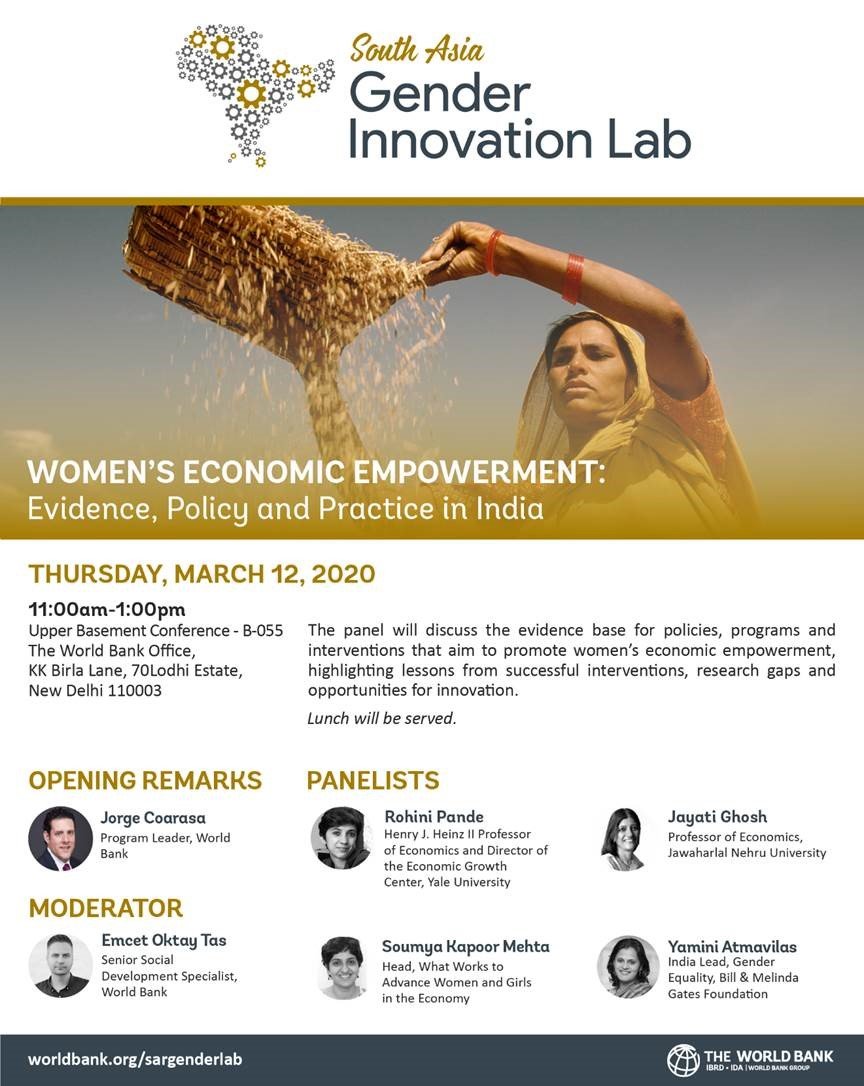
Panel Discussion on Women’s Economic Empowerment: Evidence, Policy and Practice in India
Organised by the World Bank South Asia, 12 March, 2020
As a part of the “South Asia Women in the Workforce Week”, a panel discussion was organised by the World Bank South Asia Regional Gender team in collaboration with the India Gender Platform to celebrate International Women’s Day.
The panel focused on the evidence base for policies, programs and interventions that aim to promote women’s economic empowerment in India. The panel highlighted the evidences and lessons from successful interventions, i.e. “what we know” and the existing research gaps in women’s economic empowerment in India and potential opportunities for innovation, i.e. “what’s missing”. The panel responded to some crucial questions on the evidence on women’s economic empowerment in India, and the need for more evidence. The discussion also revolved around innovative ideas for future research, policy, and practice and the lessons to be learned from other countries and regions.
Speakers also shared their motivation that gives hope and drive and to continue their respective invaluable work. They also shared examples of efforts in South Asia and India that inspires a shift in the current thinking and practice on women’s economic empowerment.
The panellist included, Rohini Pande (Henry J. Heinz II Professor of Economics, Director of the Economic Growth Center, Yale University), Jayati Ghosh (Professor of Economics, Jawaharlal Nehru University), Jorge Coarasa (Program Leader, World Bank), Yamini Atmavilas (India Lead, Gender Equality, The Bill and Melinda Gates Foundation), and Soumya Kapoor (Head, IWWAGE)
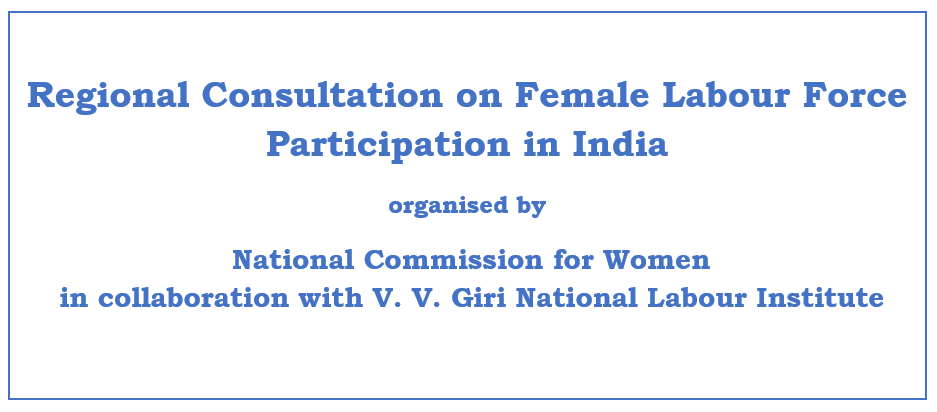
Organised by National Commission for Women in collaboration with V.V.Giri National Labour Institute
March 6, 2020
The National Commission for Women in collaboration with the V. V. Giri National Labour Institute has proposed to conduct five regional consultations on matters relating to working women, especially those in the unorganised sector to understand the factors affecting female labour force participation. The regional consultations will be held in Cuttack, Guwahati, Bengaluru, Gandhinagar and Delhi in collaboration with respective National Law Universities (NLUs). The Cuttak consultation was held on March 6, 2020.
The regional consultations will be deliberating on issues related to women’s participation in the labour market and the constraints which women face to continue in paid employment. There would be an attempt to understand the relationship between female labour force participation (FLFP) with informality, unpaid care work, gender-based violence including workplace harassment, marriage, socio-cultural norms, social protection, labour regulations etc. The consultations will also bring to light a range of factors with a focus on region specific factors affecting women’s paid work and highlight on the necessary policy interventions/action plans that need to undertake at a regional level for addressing the issues related to declining female labour force participation. This would be a platform for sharing of good practices and experiences addressing FLFP. The regional consultation will be bringing together experts and practitioners working on gender and labour issues including scholars from the academia, government (Ministries concerned), State Commissions on Women, international organizations, and other organisations.

Senior Research Fellow
Bidisha has worked extensively in various dimensions of socio-economic inequalities. Her core research interests lie in analyzing gender gap and discrimination faced by marginalized social categories in Indian labour market. Besides, she has thoroughly studied the trends in healthcare expenditure among Indian households and various kinds of inequalities existing there.
Bidisha has completed her masters from University of Calcutta and Ph.D. from Centre for Economic Studies and Planning, Jawaharlal Nehru University, New Delhi. Her doctoral study looks into various kinds of labour market segmentation in Indian manufacturing sector.
Before joining IWWAGE, Bidisha has worked with National Institute of Public Finance and Policy for more than four years. Her research works got published in many peer-reviewed journals of national and international repute.

Research Associate
Nidhi is a Research Associate at IWWAGE. She holds an undergraduate degree in Mathematics from Miranda House, University of Delhi and a Masters in Economics from Ambedkar University Delhi. She has been a visiting student at Indira Gandhi Institute of Development Research, Mumbai, where she worked in the domain of labour economics, around the status of women’s participation in the labour force in major states of India. She is currently engaged in creating state factsheets for India, describing major trends in women’s workforce participation, using the recent PLFS data. Her areas of interest include applied microeconomics, feminist economics and Marxist political economy.

Research Associate
Ayushi is a Research Associate at IWWAGE. She completed her Post-graduation in Economics from Ashoka University and holds a Bachelors in Economics degree from Kamala Nehru College, University of Delhi. Previously, Ayushi has been associated with the Institute of Economic Growth (IEG) and Centre for Budget and Governance Accountability (CBGA) and has worked closely on matters of revenue mobilization. She is interested in issues of gender and caste discrimination especially with respect to resource allocation.
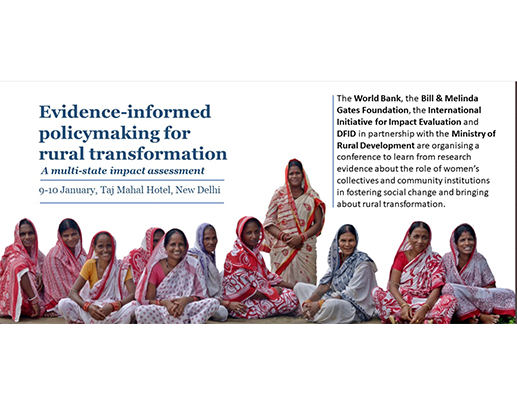
Exploring the Role of Women’s Collectives and Community Participation
9-10 January 2020, New Delhi, India
The World Bank, the Bill & Melinda Gates Foundation, the International Initiative for Impact Evaluation, and DFID in partnership with the Ministry of Rural Development organised a conference on the evidence and learning from the national rural livelihoods programs, state projects and the implications for evidence-informed policymaking. The conference brought together policymakers, researchers and development practitioners to understand how evidence can feed into programmes and policies.
As a part of the two-day conference held in New Delhi, Institute for What Works to Advance Gender Equality (IWWAGE), organised a session: Can rural livelihoods interventions reshape deep rooted social and gender hierarchies?
The session revolved around efforts, experiences, and evidence on building gender-intentional programming with NRLM. The session featured lessons from a program on engendering livelihoods led by ANANDI in a pilot program in Madhya Pradesh; the experience and learnings from Kudumbashree’s Gender Programming including the Gender Self Learning Program and Snehitha; the design of a multistate program of work to engender NRLM and strengthen institutional mechanisms for gender through Gender Resource Centres; and finally, NRLM’s efforts to integrate gender through the program.
The presenters included Nita Kejrewal (JS, MoRD); Usha Rani (Lead, IB/CB, Gender, and FNHW, NMMU); Yamini Atmavilas (BMGF); representative from Kudumbashree, Govt of Kerala; Soumya Kapoor and Divya Hariharan (IWWAGE-LEAD, KREA University).
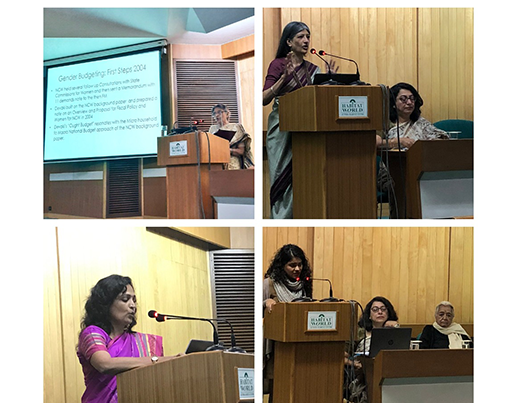
A One-day Stakeholder Consultation for Informing the Union Budget (2020-21) Organised by Feminist Policy Collective in partnership with UN Women Multi Country Office (MCO) for India, Bhutan, Maldives and Sri Lanka
18 November 2019
Over the years, line Ministries in India with the Ministry of Women and Child Development (MWCD) as an anchor, have undertaken several gender mainstreaming and Gender-Responsive Budgeting (GRB) efforts. This also included supporting a Working Group of Feminist Economists (WGFE) within the erstwhile Planning Commission. UNIFEM and UN Women supported much of this work in the past and contributed to inclusion of intersectional and marginalized perspectives into planning and budgeting processes at national and state level.
As Government of India launches its efforts for developing the Union Budget (2020-21), the Feminist Policy Collective (FPC) proposes to bring together government, policymakers, researchers and practitioners from across the country, working on GRB and feminist financing across sectors, to discuss and deliberate on persistent challenges at national and state level, as well as to identity promising practices that can be replicated and upscaled in the upcoming budget. FPC works on Transformative Policy and Financing for Gender Equality. It is run by an independent network of academic researchers, policy experts, and campaigners who are committed to strengthening gender transformative policies, plans, and budgets in India.
Based on a situational analysis undertaken by the FPC to inform this consultation[1], the following thematic areas, strategies and mechanisms for GRB and financing have been prioritized: (a) women’s economic empowerment, (b) data and statistics, (c) platforms for gender-responsive and intersectional planning and (d) institutional mechanisms and accountability for GRB and financing.
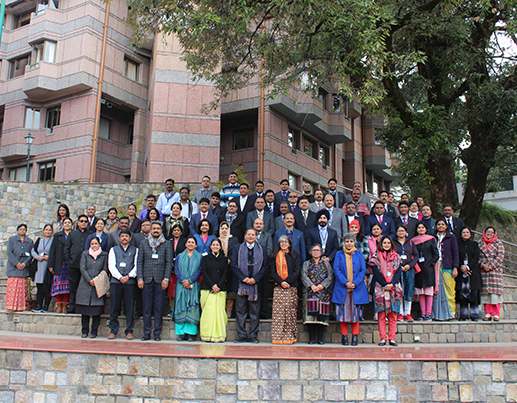
IWWAGE partnered with the National Gender Centre at the Lal Bahadur Shastri National Academy of Administration (LBSNAA) to support a series of workshops on multi-agency coordination to address violence against women and children. The first among a series of three workshops was organised on 19-21 December,2019 at the academy in Mussoorie, Uttarakhand. The workshop brought together officials serving in the field of administration, law enforcement, judiciary and medical services, and those who have been engaged in investigating and prosecuting cases of violence against women and children. The three-day workshop included sessions on intersectionality of gender, legal scenario and current context in India, understanding violence from a victim’s perspectives, and institutional mechanisms that exist to prosecute cases of violence, including group work on several case studies that dealt with such cases.
Capacity Building Program in Tackling Violence against Women and Children in India

IWWAGE along with the Feminist Policy Collective (FPC), hosted a panel discussion on Violence and the Political Economy of Work at Indian Association of Women’s Studies Conference 2020 (IAWS), held at the National Law University (NLUD), Delhi from 28-30 January, 2020.
The panel on Violence and the Political Economy of Work focused on identifying and unravelling of the political economy of production-patriarchy interdependency, and the interlinkages between the continuum of work and the continuum of violence. The panelists talked on the multiple strands of work and violence woven together based on ground realities and linkages to economic policies. The interconnectedness of the domain was explored to develop a nuanced critique of the political economy of work and to give directions for future strategy. The panel addressed topics around:
Speakers:
Moderator: Subhalakshmi Nandi, Feminist Policy Collective (FPC)
Discussant: Chirashree Das Gupta, Jawaharlal Nehru University
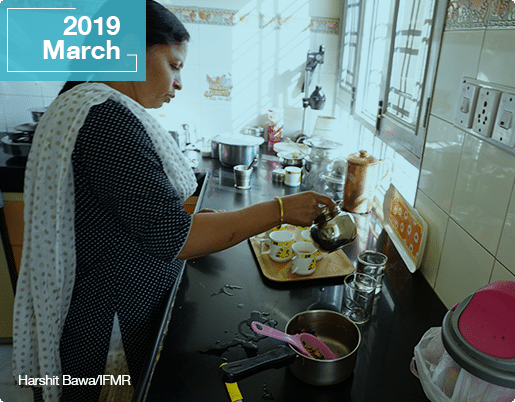
7-8 March, 2019
Organised by: ICRW and VVGNLI
IWWAGE participated as a presenter at the two-day workshop to commemorate International Women’s Day. The workshop saw participation from experts and practitioners working on gender and labor issues, including scholars from various academia, concerned ministries from the government, international organisations, and civil society.
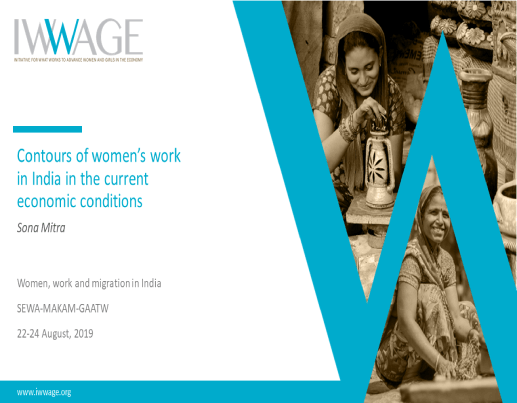

IWWAGE participated in the ‘What Works Global Summit held in Mexico City, 14-18 October, 2019.
The panel on ‘Importance of evidence creation in women’s economic empowerment (WEE) in India’ proposed by IWWAGE was moderated by Yamini Atmavilas of the Bill and Melinda Gates Foundation. The panel focussed on WEE as a major policy concern in India. The panellists presented data and evidence to action initiatives operating at the national and sub-national levels of governance in India.
Madhuparna Joshi from C3 leading the IWW-Bihar work, highlighted the mechanisms such as creating state report cards and a dashboard to help fill in evidence gaps that informed policies focussed to enhance women’s safety and mobility in the state of Bihar. Sona Mitra from IWWAGE at LEAD, Krea University presented a synthesis of their work with the government focussing on creating evidence for actionable policies to – reduce the burden of women’s unpaid work, improve the quality of work for women and the challenges and mechanisms of working with the government in India. Soledad Prillaman from Stanford University, presented her findings on an evaluative evidence building of the forward linkages of the skilling program in the state of Odisha and provided insights on strengthening those in order to achieve success in the skilling initiatives for young girls. The participation in the session was encouraging with a vibrant discussion that followed the presentations. Ms. Atmavilas summed up the discussions through her final comments focussing on the need for more such evaluative evidence building that would inform future policy initiatives for WEE.
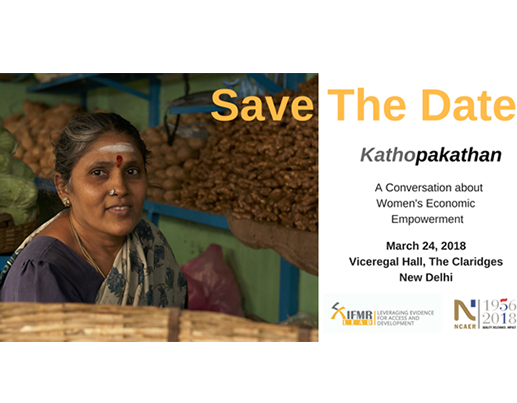
Organised by The NCAER-National Data Innovation Centre (NDIC) and Institute for Financial Management Research-India Initiative for What Works (IFMR-IIWW)
NDIC and IFMR-IIWW jointly organised an initiative, Kathopakathan (conversation) on Women’s Economic Empowerment in New Delhi, attended by representatives from the spheres of research, policymaking, and data collection. The discussions at the Kathopakathan event are part of a series of activities to be undertaken by NCAER-NDIC for building research capacity, and promoting innovation and excellence in data collection in the country. The interactive sessions at the event revolved around two themes surrounding women’s economic empowerment –
How can policy opportunities enhance women’s economic empowerment through participation in the workforce by countering the constraints faced by them in the labour market?
Should the nature of data collection change given the evolving nature of work and contextual factors that influence such activities, especially since the available data sets on women’s economic participation like the NSS have apparently not kept pace with far-reaching changes in labour markets?
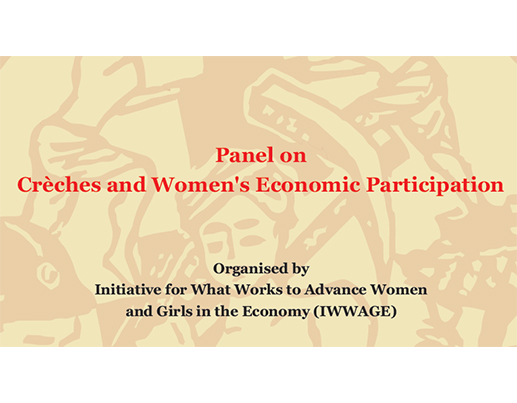
December 7-9, 2019
Panel title: Importance of creches for women’s economic participation
Panel abstract: Barriers to maternal employment or unpaid care work for women is an important area of research to engage effectively in the productive economic activities and thus forms an important labour right for women. Evidence around women’s unpaid work constitute almost 65% of all work performed by women, 10-12% of which include taking care of children and family members. It is in this context that the models of quality centre-based childcare and its impact on maternal employment has shown effective results for Nordic countries and also in certain Latin American countries (in studies conducted by IWWAGE) which have replicable practices for developing economies. In India, the discourse around creches has remained stunted at the level of providing such facilities at worksites. This panel attempts to present evidence on the positive impact of centre-based childcare on women’s engagement in economic activities across the world as well as in the local context, potentials of centre-based childcare to reduce women’s time for care activities as well as improve earning abilities of women with such systematic and quality support in childcare. The objective of the panel is to strengthen evidence around this topic to be able to reinforce the rights-based discourse around women’s fundamental labour right of being economically active.
Panelists: Anoushaka Chandrasekhar, IFMR LEAD; Monika Banerjee (ISST), Sudeshna Sengupta (formerly Mobile creches)
Discussants: Susan Thomas (SEWA)
Moderator: Kanika Jha Kingra (IWWAGE)
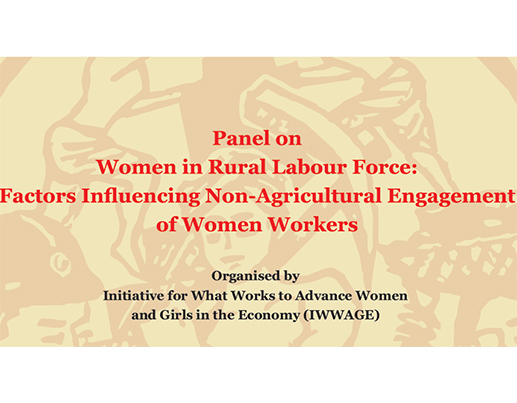
December 7-9, 2019
Panel title: Women in rural labourforce: Factors influencing non-agricultural engagement of women workers
Panel abstract: Labourforce statistics in India clearly show that women’s work in rural areas remain concentrated in petty activities in the secondary and service sectors that are usually low paid, low-value added and do not have much potential for intersectoral and vertical mobilities. The existing opportunities are either unremunerative and does not meet women’s expected working conditions and returns from labour or are those that require training, education and skills that are not imparted efficiently for engaging women or those that are determined by the women’s social identities. The thrust towards use of advanced technology has also ushered in a different regime of work for women alongside the traditional methods of organisation of work, for instance in the emerging ‘gig work’ or increasing use of digital platforms for women’s economic collectives or facilitating financial inclusion of women and so on. This panel proposes to deliberate and discuss on these several aspects of ‘what works’ to reverse such declines in women’s engagement; importance of education, skill and training; role of social identities; use of technology and macroeconomic factors influencing economic opportunities for women.
Panelists: Atul Sood (JNU), Anjana Thampi (IWWAGE), Dipa Sinha (AUD), Nitya (SEWA), Ruchika Chaudhary (IWWAGE)
Discussant: Amit Basole, Centre for sustainable Employment, APU and Uma Rani, ILO
Moderator: Sona Mitra, IWWAGE
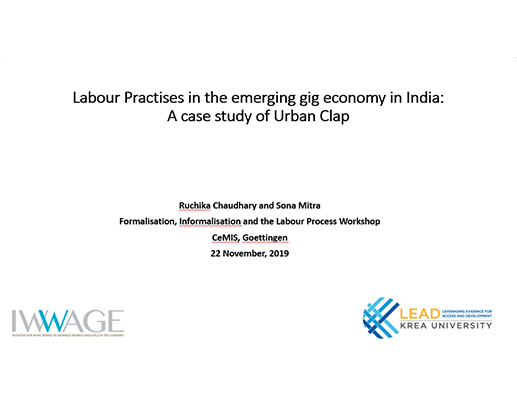
Participation at the workshop titled “Formalisation, Informalisation and the Labour Process”, at the University of Göttingen, Germany
Dr Ruchika Chaudhary (Senior Research Fellow), and Dr Sona Mitra (Principal Economist) at Institute for What Works to Advance Gender Equality (IWWAGE) at LEAD, attended a stimulating workshop, “Formalisation, Informalisation and the Labour Process“, organised by the Centre for Modern Indian Studies at the University of Göttingen, Germany, during 20-22 November, 2019.
They presented a paper entitled, “Labour practises in the emerging gig economy in India: A case study of UrbanClap”. India has seen the emergence of the gig/platform economy, fuelled by technological advancements, and mobile application based (app-based) business models are thriving in the country. As a result, new non-standard forms of work are evolving, and thereby blurring the classical production boundaries, and changing the standard employer-employee relationship. Their paper unpacks these changes and put forth some of the explanations for the changing labour practices, commodification of labour and increased informalisation in the rapidly emerging gig economy of India, by focusing on female beauty and salon service providers of UrbanClap (known service platform), in Delhi and Mumbai. The study was supported by Asia Foundation.
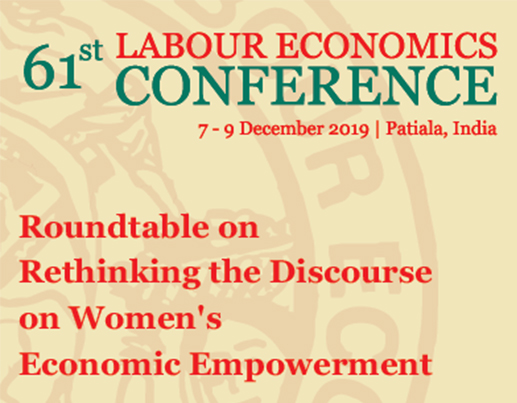
7 December, 2019
Panel title: Rethinking the Discourse on Women’s Economic Empowerment
Organised by: Centre for Gender Studies at IHD, BMGF and IWWAGE
The continuing attention to gaps in women’s economic empowerment and declining LFP in India has opened up both persistent and newer barriers (and enablers) to women’s economic participation, agency, and decision-making vis-à-vis markets, states, households and communities. A wide range of investigations have been looking beyond questions of restrictive cultural norms to look at measurement of women’s work; labor market discrimination; non-sharing of domestic chores; forms of women’s unpaid work; lack of suitable jobs; low human capital investment including education and skilling; fertility; education and so on. Discussions around macroeconomic policies, trade regimes, low social protection especially for informal sector workers, and decreased expenditure on health care are often left out of the framing of women’s economic empowerment. Discussions on power that are core to the very idea of empowerment are also sometimes missing in more recent work rooted in behavioral economics. Women’s collective solidarity economies receive little mention in favor of large technocratic platform economies. We also see that globally the discourse around women’s economic empowerment has been expanding: the discourse around the world of work for women has been transforming thanks to the future of work discussions, the ILO’s widening the definition of ‘work’ to include women’s unpaid work, the ILO’s resolution on violence and work that goes beyond sexual harassment. More recently, looking at SHG programs through the lens of labor has also begun to bring newer theoretical and conceptual possibilities. This roundtable seeks to bring experts together to re-invigorate discussions on women’s economic empowerment in India and shape a research and policy agenda. These could include bringing together and synergies around macro, LFP, and empowerment and violence literatures, connecting across breaches in the WEE literature – such as market-based, labor-based, and norms-based approaches, and exploring where we need new and/or deeper theorizing for WEE in India.
Report_Rethinking the Discourse on Women’s Economic Empowerment
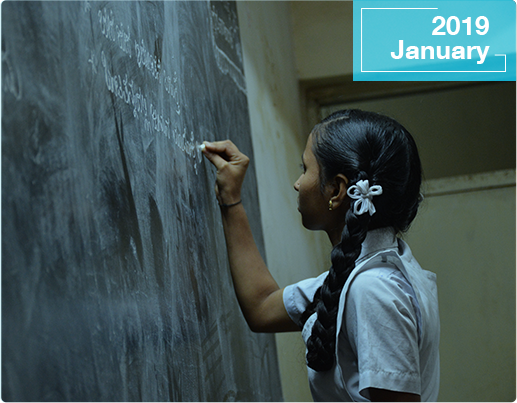
IWWAGE and the Institute of Social Studies Trust co-organized a day-long round table discussion on “Women’s Employment Within an Entrepreneurship Model”.
The discussion was held on January 21, 2019 in New Delhi.
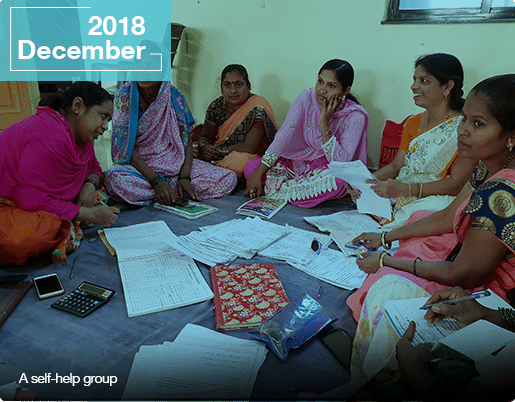
The Institute for What Works to Advance Gender Equality (IWWAGE), through its Centre of Excellence on Women’s Empowerment Collectives, organized a breakfast roundtable on “SHG Federations for Women’s Economic Empowerment: Setting a New Agenda” on December 11, 2018 in New Delhi.
The discussions revolved around the following thematic areas :
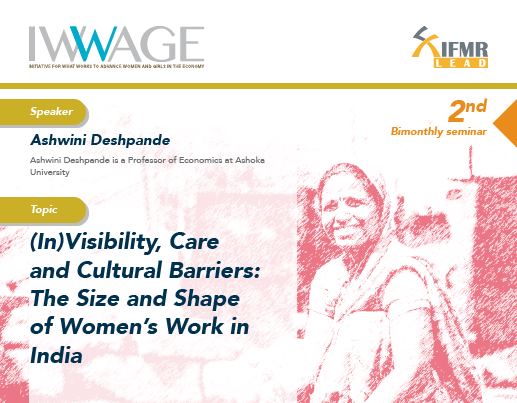
IWWAGE is hosting a seminar on (In)Visibility, Care and Cultural Barriers: The Size and Shape of Women’s Work in India, by Ashwini Deshpande, Professor of Economics, Ashoka University.
The talk will focus on the reasons underlying low labour force participation of women in India based on a recent study. The study discusses the interlinked complexities of women’s choice, constraints posed by domestic work and care responsibilities, and the predominant understanding of cultural norms as factors explaining the low labour force participation as measured by involvement in paid work.It addresses aspects of mis-measurement of women’s work due to the fuzziness of boundaries between domestic work and unpaid (and therefore invisible) economic work. The study also highlights the extent of women’s unmet demands for work.
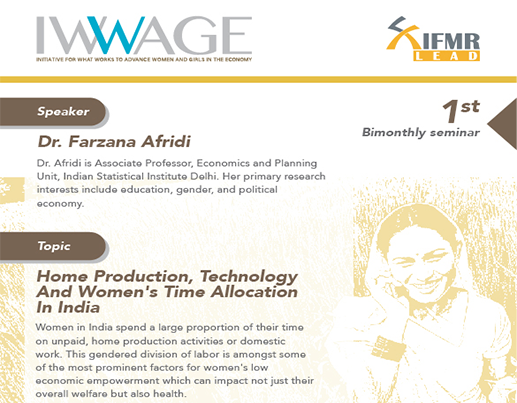
Home Production, Technology and Women’s Time Allocation in India
Dr Farzana Afridi, Associate Professor, Economics and Planning Unit, Indian Statistical Institute
The talk focused on documenting trends in women’s time allocation between market, home production and leisure. It highlighted the possible role of technology in reducing the time allocated to domestic work by women and potentially improving their health.
The discussion was held on May 17, 2019 in New Delhi.
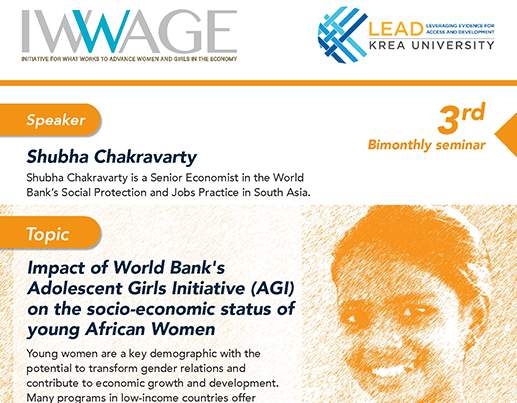
Impact of World Bank’s Adolescent Girls Initiative (AGI) on the socio-economic status of young African Women
Shubha Chakravarty, Senior Economist in the World Bank’s Social Protection and Jobs Practice in South Asia
Young women are a key demographic with the potential to transform gender relations and contribute to economic growth and development. Many programs in low-income countries offer evidence to economically empower young women, however, the scale of these are often limited. In this context, the talk highlighted evidence from a set of World Bank-supported projects in seven low-income countries in Africa under the Adolescent Girls Initiative for scaling up of women’s empowerment programs and the consequent socio-economic impact. The talk put light on competing models and the “best practice” for young women’s economic empowerment, and scaling up of similar programs in India and West Africa.
The discussion was held on October 30, 2019 in New Delhi.
Resources
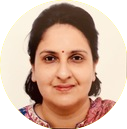
Head, IWWAGE
As the Head of IWWAGE, New Delhi, India, Ms. Soumya Kapoor Mehta leads IWWAGE’s efforts to generate, leverage, and synthesize evidence on women’s economic empowerment.
Soumya has an experience of nearly 18 years in the development sector, spanning research around gender, women’s empowerment, poverty reduction strategies, social inclusion challenges and policy levers to alleviate them around the world.
Prior to joining IWWAGE, she was working as an independent policy advisor for the World Bank, UNICEF, the Government of India, the Centre for Policy Research and the Self Employed Women’s Association (SEWA), helping these institutions mainstream inclusion and gender issues in their research and projects ranging from investments in women’s collectives (NRLM), to sectors such as water, agriculture, infrastructure, urban development and environment and climate change. She has co-authored several World Bank and UNICEF research outputs, including some of their flagship reports and has two widely acclaimed books to her credit. Between 2003 and 2009, she worked as full time staff for the World Bank anchoring a large cross-country study on poverty and strategies to reduce it.
Soumya has a Tripos Degree from the University of Cambridge in Economics and a B.A. (Hons.) in Economics from St. Stephen’s College, Delhi University. She has also been a Visiting Fellow to the John F. Kennedy School of Government, Harvard University.

Economist
Mridusmita is an Economist at IWWAGE, an initiative of LEAD. She has 20 years of research experience, primarily in the areas of India’s labour market, education sector, child protection, and household sector income & consumption patterns in India. Her research work has been largely based on quantitative analysis of official large-scale surveys (NSSO, PFFS, NFHS, ASI), census (Census of India, U-DISE Plus), macro-economic datasets, and India’s public finances (Union budget, State budgets, and District treasuries). She has extensive experience in conducting primary surveys, including sampling design, questionnaire designing, and training. She has focussed on understanding the status of provisioning of public welfare services in the social sector, equity in outcomes, and implementation of various policy interventions. She has studied the implementation processes of centrally sponsored schemes related to education and child-protection sectors, including analysis of public finances and governance structures. She has also conducted fund-flow tracking surveys to understand last mile reach of public finances and utilisation of budgets. In the area of labour market, she has worked on financial returns to education, informality, social security of unorganised workers in India, linkages between education and labour market, and gender-gaps in labour market outcomes. Currently she is engaged in research to understand challenges related to women’s labour market participation in India and ways of enhancing women’s work participation.

Research Fellow
Anjana Thampi is a Research Fellow at IWWAGE, and works with the Research and Analysis team. She is a development economist motivated to understand the problems of unemployment, women’s under-representation in the labour market, and market and non-market forms of discrimination and exclusion. Her areas of interest include gender, employment, food security and inequality.
Prior to joining IWWAGE, she has worked at the Centre for Sustainable Employment at Azim Premji University, Bengaluru. She has done her PhD at Jawaharlal Nehru University. Her doctoral thesis assessed whether food provisioning programmes have mitigated the mismatch between economic growth and nutritional indicators in India, and explored the impact of two such programmes on child nutrition and inequality. She has experience in applying statistical tools to large datasets. She has also worked and published on the high and rising levels of wealth inequality in India, and contributes opinion pieces on contemporary issues.

Research Assistant
Hiya Singh Rajput is a Research Assistant at IWWAGE. She is an Economics graduate from Miranda House, University of Delhi and a post graduate in Economics from Ambedkar University Delhi. She engaged with several government and non-government organisations such as An-gawadi, Girl Rising India, Delhi Queer Pride, The WordsWorth Project and the Enabling Society at Miranda House. She is especially interested in the issues of gender and sexuality. Her long term goal is to work as an economist and policy analyst after completing her post-doctoral stud-ies.

Senior Research fellow
Ruchika Chaudhary is an economist with over eight years of experience at the national as well as the international levels. She has worked extensively on the issues of labour and employment and specifically in the areas of gender equality and non-discrimination in Asia and the Pacific. She specializes in large-dataset and micro-dataset management, econometric analysis and modelling. She has a doctorate in Economics from the Centre for the Study of Regional Development, Jawaharlal Nehru University, New Delhi. Her doctoral thesis explored the complex issue of women’s work in India, in which their labour force participation behavior was examined. This included interviewing and elaborated analysis of domestic workers, as an important group of urban women workers.
Before joining IWWAGE, Ruchika has worked with the International Labour Organization’s (ILO) Regional office for Asia and the Pacific, Bangkok, and ILO’s Decent Work Team for South Asia and Country Office for India, New Delhi. She has also worked for the University of Manchester’s research project on ‘Use of Blockchain in ending Child labour’, taught undergraduate courses on economics at the University of Delhi, and conducted research on ‘urban poverty’ at the Institute of Economic Growth, and the National Institute of Urban Affairs. She has been awarded University Grants Commission’s Junior Research Fellowship in Economics. She has published her research in journals, edited books, and participated in various national and international forums.
IFMR LEAD is a non-profit research organization based in India conducting high-quality scalable action research and outreach in development economics and finance.
They specialize in conducting policy-and action-oriented research by partnering with influential stakeholders to inform policy-making debates. IFMR LEAD collaborates with leading professors and economists, development specialists, and industry experts on research design and implementation, and data analysis and dissemination.
Ministry of Women and Child Development (MoWCD) aims to empower women and their environment so that they may live a better life with equal opportunities.
The body works on creating a violence-and discrimination-free environments, while helping women contribute as equal partners in social and economic development.
IWWAGE is partnering with MoWCD to undertake an assessment of Women’s Helpline ‘181’.
National Rural Livelihood Mission is a poverty alleviation project implemented by Ministry of Rural Development, Government of India. This scheme is focused on promoting self-employment and organization of rural poor.
Chhattisgarh Infotech Promotion Society (CHiPS) is the nodal agency and prime mover for propelling IT growth and implementation of the IT and e-Governance projects in the State of Chhattisgarh.
Project Concern International (PCI) has been working in India since 1998. It maintains a diverse portfolio, working in both rural and urban settings in the areas of integrated health and community development with programs focusing on low-income, vulnerable, and hard-to-reach populations, especially women of reproductive age and children.
Area Networking and Development Initiatives (ANANDI), has been working with over 10,000 rural poor women from four districts of Gujarat since 1995. Forming women’s collectives and working towards changing the nature and direction of systemic forces which marginalize women has been an integral component of ANANDI’s work in Gujarat.
The Government of India established the National Rural Livelihoods Mission (NRLM) to implement the new strategy of poverty alleviation woven around community-based institutions. The Mission’s primary objective is to reduce poverty by promoting diversified and gainful self-employment and wage employment opportunities for sustainable increase in incomes.
Chhattisgarh Infotech Promotion Society (CHiPS) is the nodal agency and prime mover for propelling IT growth and implementation of the IT and e-Governance projects in the State of Chhattisgarh.
Ministry of Women and Child Development (MoWCD) aims to empower women and their environment so that they may live a better life with equal opportunities.
The body works on creating a violence-and discrimination-free environments, while helping women contribute as equal partners in social and economic development.
IWWAGE is partnering with MoWCD to undertake an assessment of Women’s Helpline ‘181’.
Indian Statistical Institute (ISI), Delhi is a public university that gained the status of Institution of National Importance by an act of the Indian Parliament. It aims to promote knowledge and use statistics for national and social-welfare planning.
ISI, in partnership with IWWAGE, conducts micro-economic analyses across different sectors — including agriculture and manufacturing — to gauge the decline in women’s workforce participation.
EPoD (Evidence for Policy Design) India at IFMR, a joint program by EPoD at Harvard Kennedy School and IFMR, engages with policymakers and practitioners to design, evaluate, and re-design policies to better serve the poor and other vulnerable groups.
EPoD also undertakes policy research with IWWAGE in Orissa, India to support SHGs in mobilizing women to take up skilled employment through NRLM.
Bill & Melinda Gates Foundation (BMGF) is a private foundation founded by Bill and Melinda Gates. BMGF aims to aid every person to get the chance to live a healthy, productive life.

Head-HR and Administration
Flawless in administrative and HR skills, Preeti is passionate towards the operations work she is doing. She has robust and more than 17 years of experience in Admin and HR management especially in the Development Sector. Prior to moving to IWWAGE, Preeti worked as an Administration Manager with Catalyst, another project of LEAD (IFMR Society) at Krea University .
She has worked with FHI 360 for a decade in various capacities including Admin Officer and supporting Country Director. She has great counseling skills.
Preeti has an Economics degree from Delhi University, Diploma in Office Management from YMCA, and Operational Management Diploma from MIT and PGPM from Great Lakes Institute.

Senior Grant Manager
Neeraj Upadhyay is working as a Senior Grant Manager at IWWAGE. He is a result oriented professional with 10 years of experience in Project Management, Partner Management, Grant Management, Donor Management, and Administration.
Prior to joining IWWAGE, he has worked with some renowned international and national development sector institutions such as Learning Links Foundation (LLF), CARE India, Action contre la Faim (ACF, Paris), and World Health Organization (WHO), where he managed many international funding agencies including BMGF, USAID, UNICEF, and FHI 360, as well as corporate donors such as Dell, Ashok Leyland, Cargill, and GSK. He has completed his Master’s degree in Project Management.

Senior Program Manager
Divya Hariharan is a Program Manager at IWWAGE, and is currently engaged in IWWAGE’s research and evidence generation activities. Her areas of expertise and interest include gender, social inclusion and accountability, and governance.
She has a blended experience of implementation, program management, strategic consulting, and research. She has played multidimensional roles across different organizations with varied mandates and priorities. She has supported in the designing, implementation, and evaluation of projects, and has worked with government and non-government (CSO, private sector stakeholders, and donors) stakeholders.
She has also worked in particularly challenging contexts across India on projects supported by the Bill & Melinda Gates Foundation, Department of International Development, Children’s Investment Fund Foundation, and UNICEF among others.
Divya has a Master’s degree in Gender from the London School of Economics and Political Science.

Associate Director
Neelakshi Mann is an Associate Director with IWWAGE at IFMR-LEAD. She leads IWWAGE’s work on women’s economic collectives with the National Rural Livelihood Mission and other partners. She has over 15 years of experience in the development sector. Prior to this, she worked with the Rajiv Gandhi Charitable Trust on achieving gender equitable empowerment through women self-help groups. She was also an adviser to the Minister of Rural Development, Government of India on rural development programs, including MGNREGA — the world’s biggest workfare scheme. With an expertise in the field of public policy monitoring and evaluation, she designed the Ministry’s first independent evaluation structure for its programs. Following that, she worked with USAID, where she helped develop a results and monitoring framework and indicators for India, in its role as a strategic partner under the Feed the Future (FTF) Initiative of the Obama Administration. She has also worked with the Academy for Education Development (AED) in Washington DC to provide support for a project on human trafficking in South Asia.
She has a Master’s degree in Public Policy from Duke University, USA and a Master’s degree in Mathematics from the University of Delhi. She co-authored MGNREGA Sameeksha: An Anthology of Research Studies, 2012.
Bill & Melinda Gates Foundation (BMGF) is a private foundation founded by Bill and Melinda Gates. BMGF aims to aid every person to get the chance to live a healthy, productive life.

